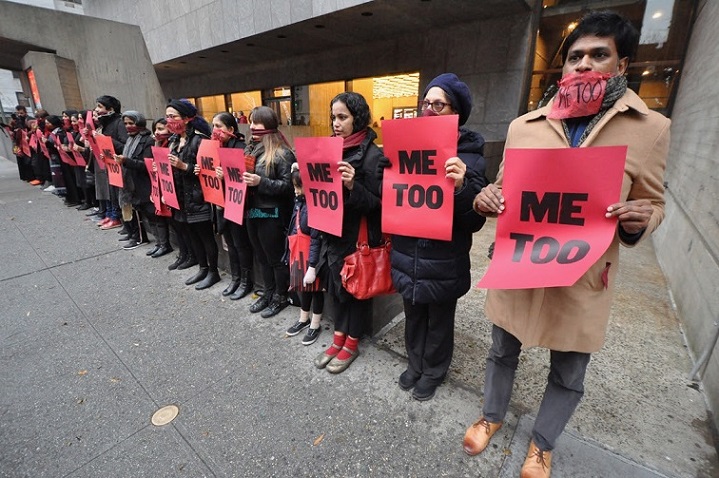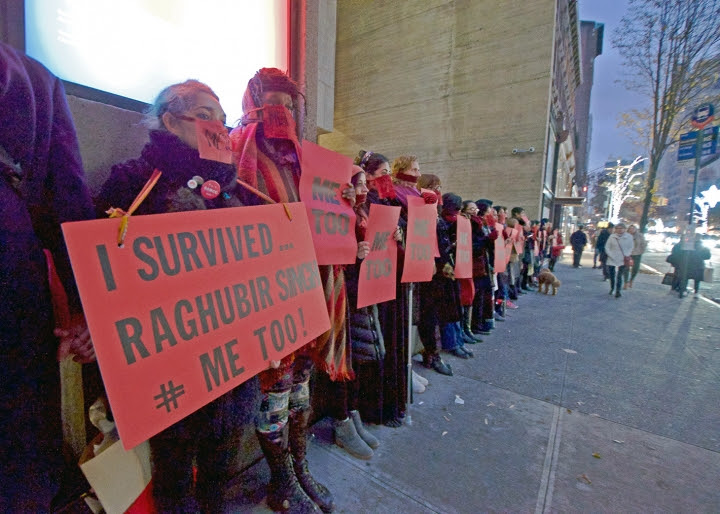Dozens of bystanders walked by the performance, including tourist Susan Shmalo. “I’m here visiting from San Diego and I’m very aware, like everybody, that #MeToo is because of Trump and all the other bad guys. And so I think its important to demonstrate like this to bring attention to it,” she told Hyperallergic. Asked if she saw the show, or if the performance would impact her perception of the artist, she replied: “I’d like to read more about him and I would like to see the show even though these people are protesting what he did, which is horrible. I think I will look at the show differently and be in sympathy with those that he hurt.”
Margaret Mary Thompson lives across the street from the museum and she was glad the performance was taking place. “Well, I love it. Everywhere across America, the ladies are speaking up. I’m all in support of them. It’s time that women not be silenced, and not be intimidated,” she said.
Museum visitors encountering the performers in the exhibition
Everyone I talked to who encountered the performance was uncertain as to how the museum should respond to the allegations, but they seemed thankful that the performance was taking place.
Critic Nadia Nooreyezdan also attended the event. After reviewing the Singh show for Delhi Arts Magazine, she received an email from South Asian Women’s Creative Collective (SAWCC) that the Met Breuer action was taking place. She says she wasn’t aware of the allegations when she wrote her review. “I think that definitely changes the way you look at the artwork,” she told Hyperallergic. “There are certain photographs in the show that I kind of read a little differently. [There were images that …] had a little red flag for me when I was looking at it, but I wasn’t sure, and now I’m taking a second look.”
A few passersby tried to talk to the performers, and at one point two middle-aged white men in black suits interrupted them, forcing one of the participants to remove her gag and tell the men to stop trying to engage them and that they should be “more diplomatic when approaching people.” As one of the men walked away, he said, “Women abuse men, too.”
A view of the performance
Abichandani told Hyperallergic about the incident with Singh, which, she says began in the mid-1990s. “When I met him, I was a 25-year-old photographer. He was the most well-known photographer in the world. He had books and books and books to his name, and like every other Indian photographer, I idolized his work because it was some of the only representation of India that was out there in the world,” she explained. “I was introduced to him through a woman … at a party. And this was a very progressive South Asian space, and so I trusted the space and him. He was double my age.”
Singh invited the young artist to accompany him after he discovered Abichandani was traveling to India. “He exploited that opportunity and he basically told me that I could travel as his assistant and he would have his publisher pay for me,” she said. “I was like, well, my family’s paying for my ticket, we’re going to be in India, I don’t need you to do this, we’re going to be there anyway. He said ‘no, no, no, no, no, I’m going to make sure they pay for your ticket.’

A view in front of the museum during the performance
“In spite of my parents’ warnings and trepidations, I went off with Raghubir Singh. His assistants had booked me hotel rooms for the first few nights after which I was told there was no money for separate hotel rooms … And I was completely trapped.” Abichandani alleges that Singh raped her during that two-week period in India.
Hyperallergic spoke to two of the artist’s friends who Jaishri had confided in at the time. Both asked to remain anonymous. One of them said Abichandani told her immediately after she returned about what happened. “She felt trapped, like a prisoner,” she explained. “At that time, being a woman in India, especially as a young woman … it was a different place so the ability to leave your situation was that much harder.”
The second friend explained that Abichandani confided in them roughly a year after the incident, when she told the person what Singh had done. While the person did not remember many details of the conversation, they did recall that she said Singh had rubbed “his body up against her.”
Abichandani hugging each performers as a thank you
Abichandani also recorded her experience in a dated diary entry that she showed to Hyperallergic. She did not report the incident to authorities at the time, because, she explained, she felt that the older artist would take revenge.
The outdoor performance concluded with a song performed by Uzuri, and then Abichandani proceeded to hug each performer as a thank you for taking part. The finale was clearly emotional for all those involved, as many took the time to share stories and experiences of their own.
“He used his art to trap me, so I can use my art to talk about my experience with him,” she told Hyperallergic about her performance.
Hyperallergic has reached out to the estate of Raghubir Singh for comment.








